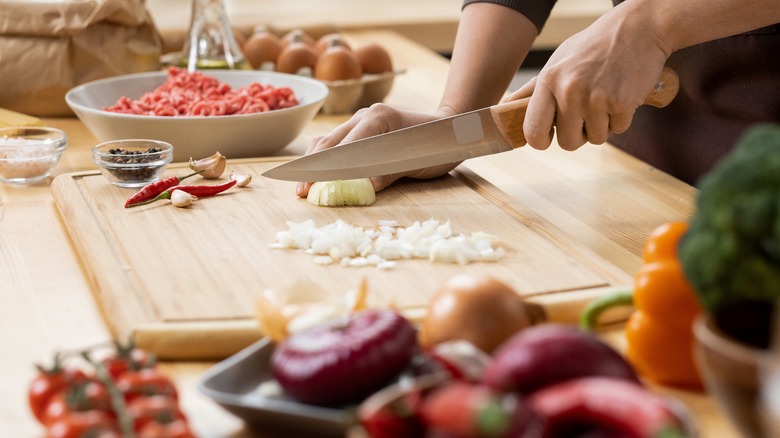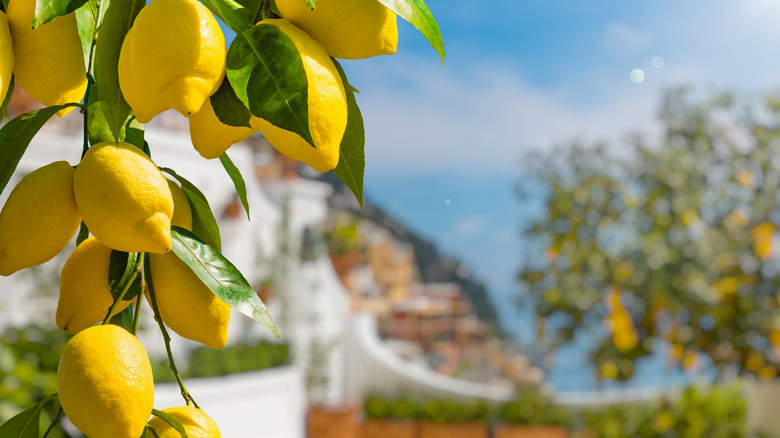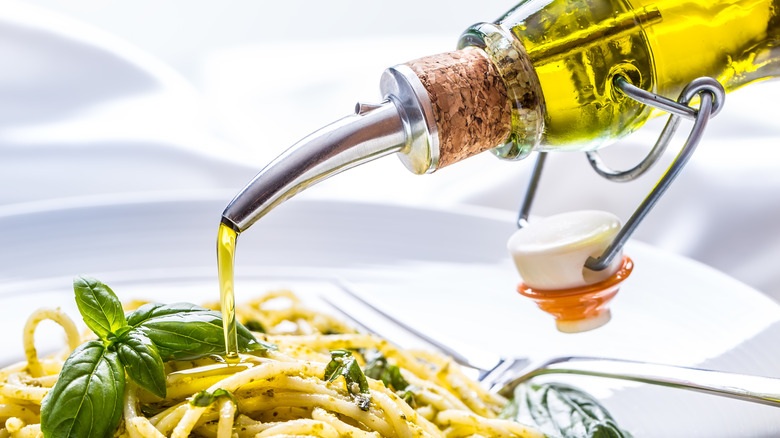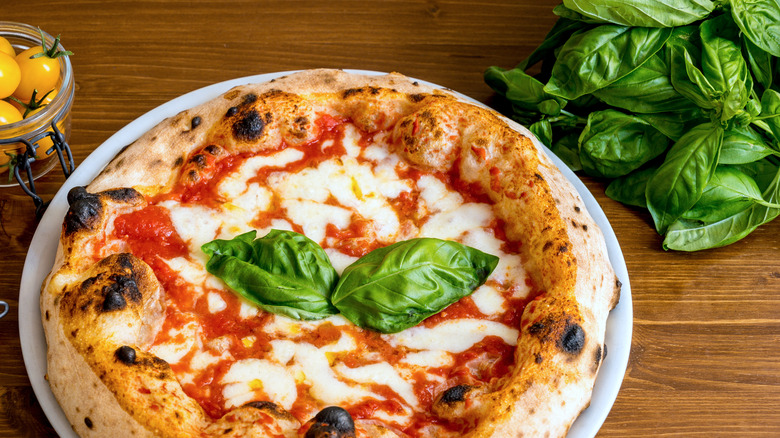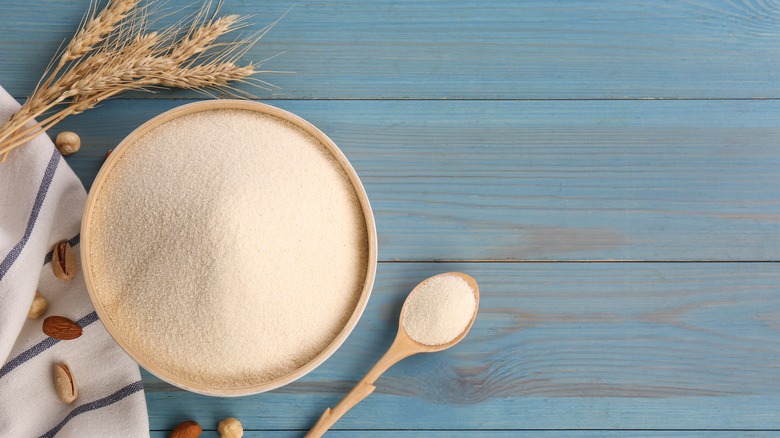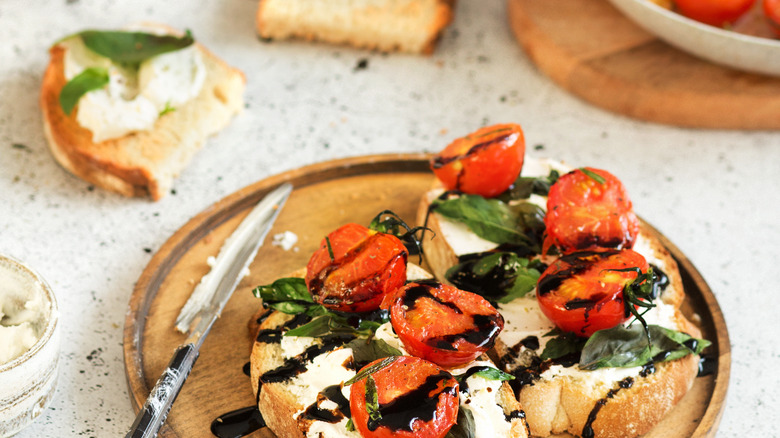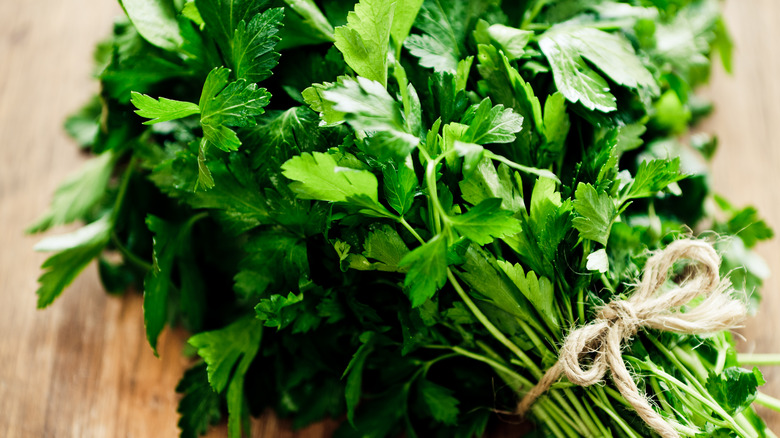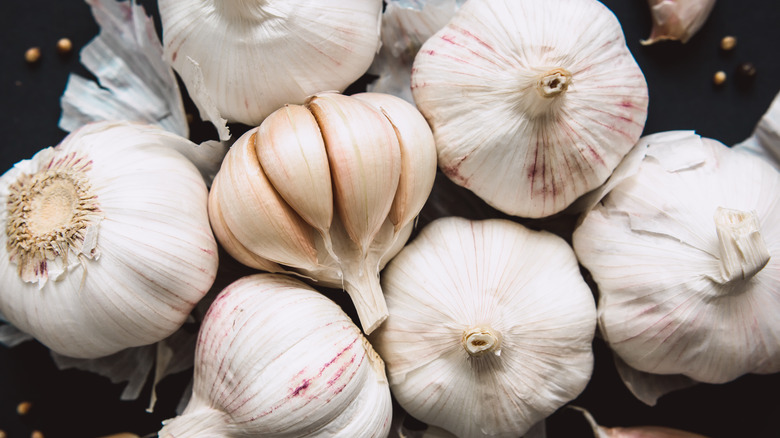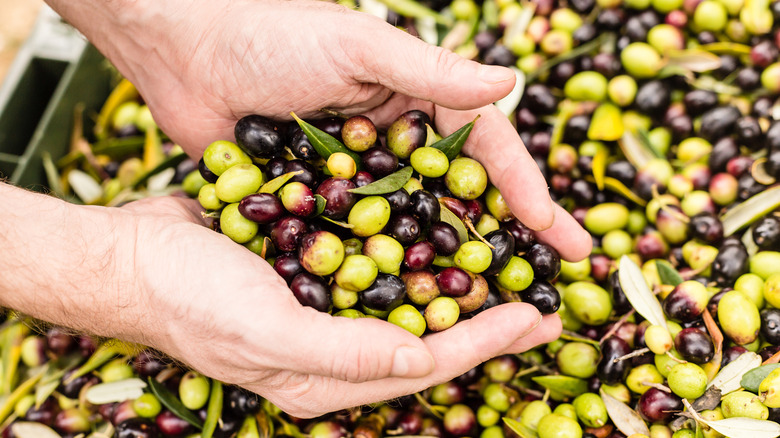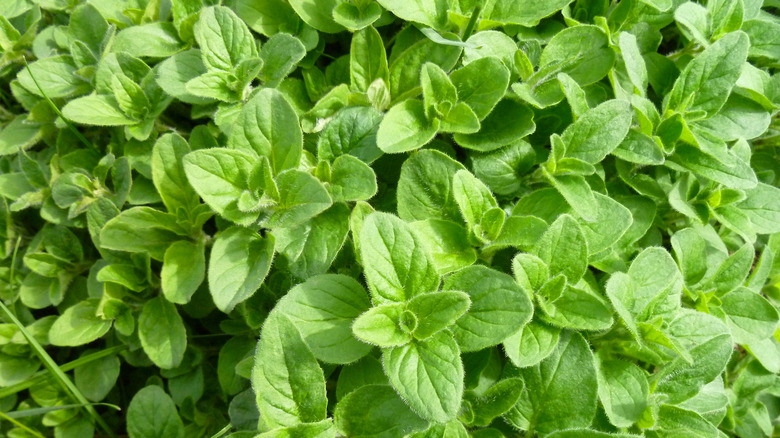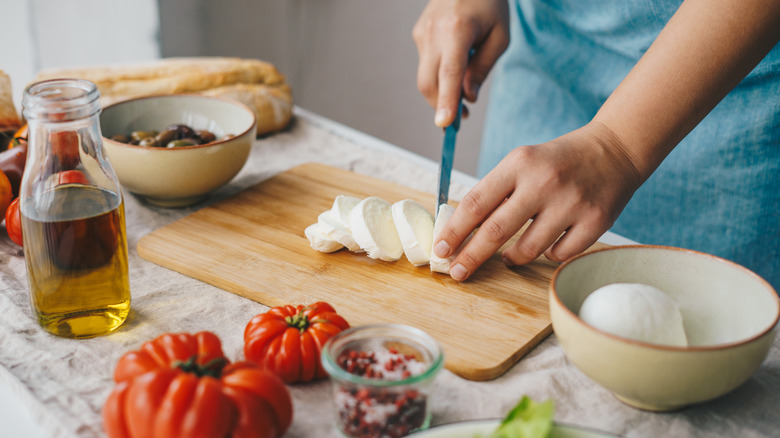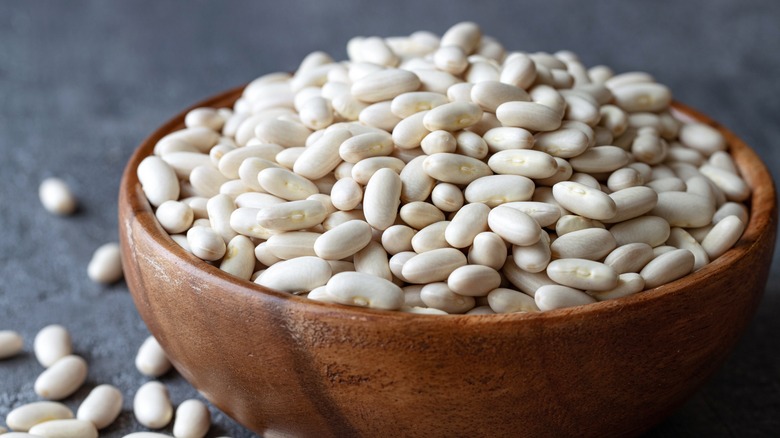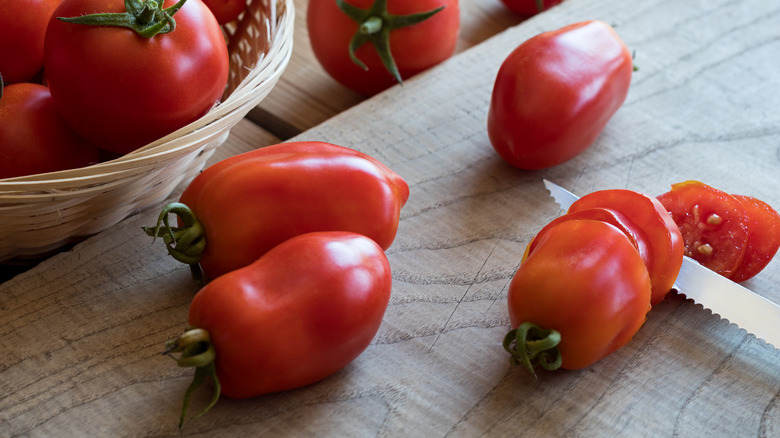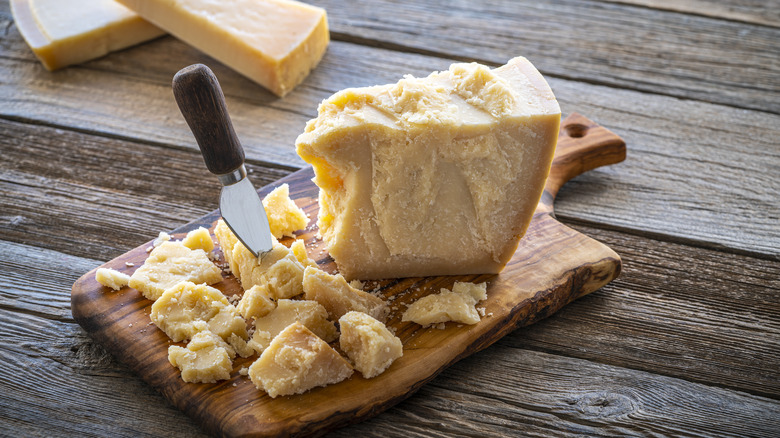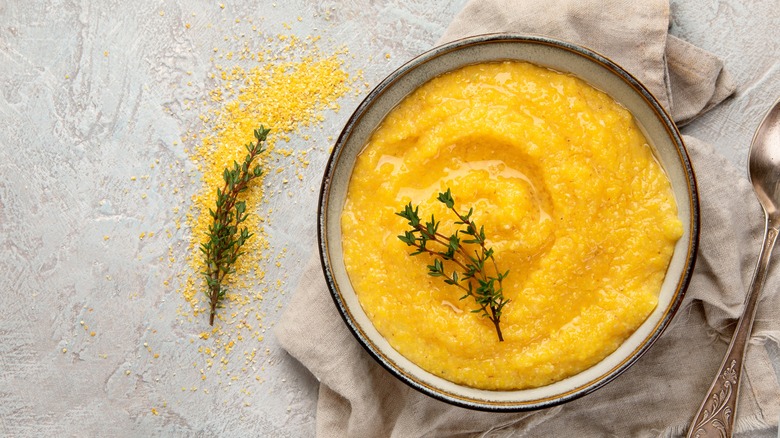15 Essential Ingredients For Italian Cooking
While it's easy to assume that Italians cook with copious amounts of melted cheese and fatty meats, in truth there is a huge difference between the Olive Garden and what Italians actually eat. If you've ever been outside the tourist areas of Italy, you know that most dishes are made with fresh ingredients: herbs, vegetables, fruits, fish and meats. Much of the cuisine is made from scratch, including pasta and pizza dough, and the cheese, wines, and olive oil are typically locally produced.
Across the Italian countryside, you'll see heavy bean and grain consumption, along with garden-grown vegetables and farm-raised meats. Along the coast, locals can't get enough seafood. While commodity culture and the convenience of pre-packed and preserved foods have made their influence all around the world, ancient Italian cooking traditions are still widely practiced. In fact, there are some essential ingredients for Italian cooking that have not wavered over the centuries at all, and it's time we cooked more with them.
If you're a huge fan of Italian cuisine, or simply trying to get back to your Italian roots, the best place to start is by stocking your kitchen with fresh, Italian staples. The next step is to learn how to properly cook with them, and pair them with anterior ingredients. In no time you'll be making pasta by hand and garnishing it with fresh herbs like a pro. Buon appetito!
Lemons
Citrus juice is a staple for top cooks around the world. The acidic component of lemons helps add flavor and balance to both sweet and savory dishes. They are tangy, slightly sweet, and have the undertone of an oily flavoring. Both the juice and the zest are used in Italian cooking. To harvest the zest, rub a zester or fine cheese grater along the outside of a clean, organic lemon. Lemon can be included in any cheese-based dish pasta, like fettuccine alfredo, tetrazzini, and lemon spaghetti, as well as paired with meats and fish.
Along the Amalfi coast, there's a particular kind of lemon that tends to steal the show. What makes Amalfi lemons so unique is their mellowness, which is a word you probably never thought you'd hear to describe a lemon. These lemons, also called sfusato lemons, are larger, more bulbous, supple, aromatic, and sweeter than your standard lemon. If you can get your hands on these special Amalfi lemons, grab some to enhance your Italian cooking.
Extra virgin olive oil
Most of the world cooks with oil, and there are endless oils from which to choose. The Mediterranean, however, is known for its heavy use of extra virgin olive oil, because of the abundance of olives that grow in that region.
For those of you who think all oil tastes the same, think again. Like wine, coffee, or chocolate, olive oil can have subtle differences in mouthfeel and flavor depending on the region where it's grown, the type of olive used, how freshly they were pressed, and how it's been bottled. Even light olive oil is quite different than extra virgin in richness, flavor, and even smoke points.
A high-quality extra virgin olive oil should have floral and fruity undertones, sometimes with herby or peppery notes. These fresh and rich oils are used to garnish dishes with flavor but are also used in the cooking process. Use it to sauté your vegetables, mix it into salad dressing, or pour over pasta dishes. If you're not sure where to start, do an olive oil taste testing to get your bearings, and brush up on tips for cooking with different types of olive oil.
Fresh basil
Italians like to keep things fresh, which is why many people outside the city choose to grow their own herbs and produce. Europeans also make more frequent trips to the market than Americans, shopping almost daily instead of weekly, resulting in fresher produce. While dried herbs are used regularly in Italian cooking, fresh herbs are also essential. Basil is used in numerous world-famous Italian dishes like caprese salad, margherita pizza, and of course basil pesto.
Fresh basil can be minced and cooked into a dish and also used as a beautiful and fresh garnish. Basil has citrus undertones, but it is delicate, sweet, and slightly spicy or peppery. It's flavorful, but mild enough that you can use a handful without overpowering a dish. It pairs beautifully with other Mediterranean herbs, any vegetable, white meats, and seafood. If you want to elevate any Italian dish, lay on the fresh herbs without apology.
Semolina flour
If you thought you'd find pasta on this list of essential ingredients for Italian cooking, you're not far off. However, instead of adding a pre-made box of Barilla to your shopping list, try cooking like a true Italian by making it homemade. The flour of choice for fresh pasta just happens to be semolina flour, and you'll want to avoid a common mistake when making fresh pasta by buying coarsely ground flour. The most finely ground semolina flour you can get is labeled as "00," and it's essential for homemade pasta.
This ground durum flour is also a great pick for pizza making — which, no surprise, is also an important part of Italian culinary culture. It has a high gluten content, which helps the flour to bind and be malleable, essential for both pasta and pizza making. If you're interested in enhancing your Italian cooking game, fresh pasta and pizza dough are the place to start. These Italian staples are not only noticeably tastier when made fresh, but are universally beloved.
Red wine
There's no arguing that Italian wines are desired all over the world. This is because not only has vino been produced and perfected in Italy for centuries, but the growing conditions for grapes are top-notch. Everyone loves to take that inaugural sip while cooking with red wine, but the true magic happens in the pot. If wine isn't a regular ingredient in your cooking, and is instead treated only as a beverage, it's important to brush up on tips when cooking with wine.
While you can choose a wine that won't break the bank, you shouldn't cook with wine you wouldn't drink. That undesirable acidity or sweetness will inevitably translate into your dish. Use wine as a marinade for meats, as alcohol dissolves fat, or splash it into sauces and soups. Be sure to let the alcohol interact with the other ingredients, as it will help boost their natural flavors on a molecular level, and let it cook off so it doesn't add harshness to your dish. Pair wine as you would for sipping; use white wine in combination with white meats, seafood, and delicate vegetables, and red wine with robust meats and hearty root vegetables. Whichever wine you decide to use in your cooking, it can also be served as a beverage alongside the dish.
Balsamic vinegar
It's likely you have a bottle of balsamic sitting on your kitchen shelf as we speak. It's also likely you use it primarily as a salad dressing.
While it does makes an incredible vinaigrette, there are endless ways to use balsamic vinegar in your cooking, especially when it comes to Italian cuisine. Balsamic is distinctive because of its incredible richness and tanginess, setting it apart from other vinegars. It carries undertones of molasses, prunes, cherries, and even chocolate. Instead of being overwhelmingly acidic, balsamic is typically more tart, delivering a formidable punch of flavor.
Balsamic vinegar is used in Italian cuisine to balance the mouthfeel of dishes, enhance flavors, and garnish anything from salads to gelato. Balsamic reduction is simply a version where the acidity of the vinegar has been cooked off, resulting in a sticky, sweet glaze. This glaze can be drizzled on pizza, used as a dip for fruit, or to create balance on a cheese board. You may have even enjoyed it as a garnish for roasted bruschetta.
Fresh parsley
Italian parsley, also known as flat-leaf parsley, is better to cook with than the standard curly variety that garnishes just about every menu item at your local diner. This is because it has a stronger flavor and more tender texture. one that blends more tactfully with other ingredients. This variety has a peppery flavor, with a refreshing citrus undertone, and is quite pleasing when paired with most Italian and Mediterranean cuisine. If you haven't been a fan of the herb in the past, you should reconsider your feelings about parsley, as it can add quite a bit of flavor to almost any dish without overpowering it.
Use parsley in your sauces and spreads, but also consider it as a tasteful garnish. Fresh Italian parsley should be an important ingredient in a homemade pasta sauce, but it is also mild enough to chop and add to salad. Speaking of salad, consider minced parsley in your salad dressing to give it an herby, peppery freshness. Similarly, it can be crushed or minced and added to marinades for most meats and seafood.
Garlic
If Italian cuisine has a calling card, it is undoubtedly a reliance on garlic. The indistinguishable scent of garlic wafts from just about any Italian kitchen, and boy can it lure in a crowd. It's heavily used in Southern Italy for sauces, marinades, and stews. Americans tend to play the garlic game when cooking Italian cuisine, the more the merrier.
When cooking with garlic, there are some essential tips you need in order to avoid common mistakes. First, garlic shouldn't be cooked at a high temperature, because it cooks quickly and is prone to browning and burning. In fact, it should only be cooked for 30 seconds or so in a hot oiled pan, or until fragrant, so it's often best to add it towards the end of a recipe, or right before liquid is added. It pairs flawlessly with any savory Mediterranean flavor including meats, fish, or produce. Almost any Italian pasta dish, sauce, grain, or pizza recipe will include at least a little garlic, so use it frequently, and abundantly.
Olives
Olives aren't just pressed for oil in Italy, they are also an important ingredient used in popular recipes across the country. In fact, they are so highly desired that they are considered a snack or appetizer all on their own.
While there are hundreds of varieties, the most popular type of Italian olives are castelvetrano, which are native to Sicily and picked while they are still green. They are buttery, and less bitter than the standard green olives you might find at your supermarket's olive bar. But just because a certain variety isn't native to Italy doesn't mean that varieties like kalamata and manzanilla aren't heavily used in Italian cuisine.
Often, you'll find olives in pasta dishes, minced into sauces, adorning salads, and roasted on pizza. Depending on the variety and preservation methods, they are often oily, meaty and salty, with fruity and tangy undertones. This is because olives are actually fruit, not vegetables, growing on trees. While Italians are all about fresh ingredients, you'll never see fresh olives at the grocery store. This is because they must be processed and cured in order to be made edible.
Fresh oregano
Unlike parsley and basil, fresh oregano has an overpowering scent and flavor that carries much intensity. We would not recommend making an oregano pesto or using handfuls of it to garnish your pasta dish. Instead, note that big things come in small packages, and just a little can go a long way. Oregano is often compared to marjoram but is less sweet. It has a bold peppery flavor, with subtly sweet undertones.
This Mediterranean herb is typically employed in pasta and pizza sauces, as well as a flavor to enhance poultry and seafood. Even just a sprig put into roasted potatoes or chicken can make an incredible difference, adding an element of depth to the natural flavors of the dish. If you're intimidated by its intensity, crush some up between your fingers to smell it, and follow the top tips you need when cooking with fresh herbs in order to allow it to enhance instead of overpower a dish.
Mozzarella cheese
Few are immune to the hypnotic flavors of mozzarella cheese. It is light, creamy, milky, refreshing, and grassy. With a spongy, watery texture, and pristine meltability, mozzarella reigns as the most common cheese used on pizza. In addition, it's a staple for the popular Italian Caprese salad, makes its way onto sandwiches frequently, and is often paired with intense flavors to help create balance.
Most commonly, Italians use buffalo mozzarella, as it has a refreshing flavor, but burrata is popularly found in salads and used as an appetizer. Burrata has an outside casing of mozzarella cheese, while the inside is made from concentrated buttery cream.
There's a reason this soft cheese is melted over pasta, pizza, meat, and vegetables. It becomes bubbly brown, and remains stringy and smooth once heated. Opt for mozzarella on your grilled pesto sandwich, over baked eggplant parmesan, or breaded and fried. Enjoy it fresh on salads, paired with fresh Italian herbs, or drizzled with extra virgin olive oil.
Cannellini beans
Although it's typical to narrow your scope to pasta, pizza, cheese, and sausage when it comes to Italian cuisine, much of the country consumes large amounts of beans. Even in American Italian restaurants, you can find dishes like pasta e fagioli (pasta with beans), but in Italy, the diversity of bean dishes is much greater. Typically cooked in a tomato-based broth or sauce, white beans seem to make a frequent appearance. Cannellini beans, in particular, are quite popular in Italian cuisine.
These small white beans are kidney-shaped and have a creamy, fluffy texture. They are nutty and slightly sweet, but mild in flavor. They are tender and quite soft, and when blended help add creaminess to any dish. Use cannellini beans in pasta e fagioli soup with rosemary, sage and pancetta, or Tuscan fagioli all'uccelletto. Take a trip to the Abruzzo region and try a sagne e fagioli recipe that includes a brothy tomato base with strips of pasta, or an Umbrian classic, scafata, made with Swiss chard and white wine. Start out by simply adding cannellini beans to your favorite broth-based pasta dish or Italian soup.
San Marzano tomatoes
When it comes to choosing which tomatoes to use for Italian tomato sauce, there is no competition. No, it's not beefsteak, cherry, or plum tomatoes that take the lead. Sitting on the winner's podium, time and time again, are San Marzano tomatoes.
The reason these tomatoes are highly desired is for their robust flavor, beefy texture, and density. They are grown in the volcanic soil of Mount Vesuvius, which gives them a special smoothness and sweetness with which other tomatoes simply can't compete. Luckily, these tomatoes are canned and sold all over the world, so it's likely that you can find them at your local grocer. However, be aware that there are many San Marzano "style" tomatoes out there, so read the label carefully to ensure you're getting the real deal.
In addition, look for the best canned San Marzano tomatoes, which include basil packed right in. It gives them an additional sweetness and depth that can help elevate any dish you choose to make. It's no surprise that Italians love their tomatoes, so when it comes to choosing a recipe to highlight the ingredient, the options are endless. Start with a simple tomato sauce for your pasta or pizza; you'll notice a difference when you include the San Marzano variety. Or, if you're feeling daring, try something a little more complicated like traditional bucatini all'Amatriciana.
Parmesan cheese
Parm, also known as Parmigiano Reggiano, is a kind of cheese that has been produced the same way for thousands of years. In fact, parmesan was first produced by monks in the Middle Ages who were looking for a way to extend the preservation of cheese without refrigeration. Boy, did they deliver. The salty, crumbly, sharp cheese remains an important part of Italian cuisine and cultural history. Surprisingly, it's only made with three ingredients: Cow's milk, salt, and rennet. Unfortunately for cheese-loving vegetarians, this makes parmesan unsuitable to consume. However, many vegetarians choose to turn a blind eye to the rennet, and we don't blame them.
Because Parmigiano Reggiano is so intensely flavorful, it is best grated on top of a dish as a garnish, or as an ingredient in moderation. In fact, you shouldn't even throw away your parmesan cheese rind, as it can be used to infuse soups and sauces.
Polenta
Polenta, which is cooked cornmeal, originated in Northern Italy where its popularity grew among the peasant communities. Corn, of course, is quite inexpensive and easy to grow, and dried cornmeal is easy to store for long periods without refrigeration. Cooked polenta can be made into a creamy grits-like texture, or can be stiffened and shaped. Polenta logs can be sliced and pan-fried, which creates a pleasing crispy outer layer that contrasts nicely with the creamy interior. It can be enjoyed sweet or savory, but a typical modern creamy polenta recipe contains aromatics like garlic and onion, sometimes parmesan cheese, and butter which makes it incredibly decadent and rich.
If you've been sticking to primarily pasta and pizza-centered Italian recipes in your kitchen, expand your horizons and make this Italian staple. Pick up some polenta, either in the form of coarsely ground cornmeal or cooked and packed into logs, and get cooking.
